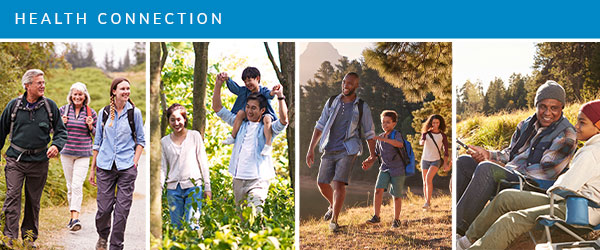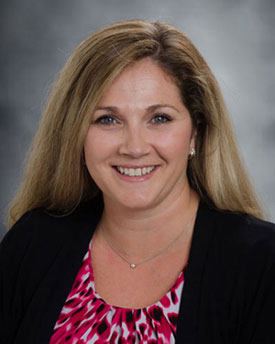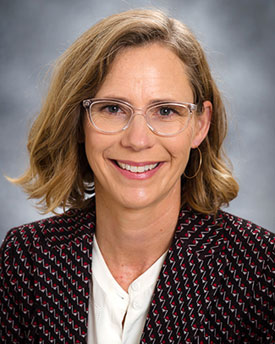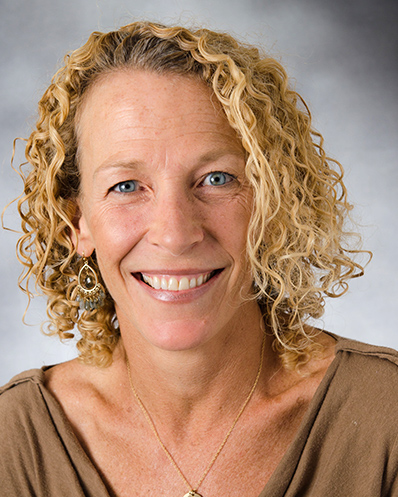Health Connection - December 2020

Mental Health Check-in: Holiday Edition
Even in normal circumstances the holidays can be stressful, but 2020 has clearly presented its own set of challenges. We asked MarinHealth’s Heather Carlberg, M.D., medical director of Behavioral Health, and Rebecca Maxwell, LCSW, director of Behavioral Health, for some advice on making the most of the holidays and how to help someone who needs emotional support.
Why do people feel more of a strain on their mental health during the holiday season?
 Rebecca Maxwell: There are many reasons like busier schedules, social obligations, religious events, remembering loved ones who have passed, and there is less daylight, which for some directly impacts mood. People often use alcohol as a pick-me-up, but alcohol impairs judgment and rational thinking. Excessive alcohol use or binge drinking may contribute to increased feelings of depression. Because of the pandemic and shelter in place, this year will have more of the same stressors and added ones, too. People may still not be able to gather with their families, social support systems or congregations. Some may have lost people in their lives and grief may be prolonged and exacerbated by the holidays.
Rebecca Maxwell: There are many reasons like busier schedules, social obligations, religious events, remembering loved ones who have passed, and there is less daylight, which for some directly impacts mood. People often use alcohol as a pick-me-up, but alcohol impairs judgment and rational thinking. Excessive alcohol use or binge drinking may contribute to increased feelings of depression. Because of the pandemic and shelter in place, this year will have more of the same stressors and added ones, too. People may still not be able to gather with their families, social support systems or congregations. Some may have lost people in their lives and grief may be prolonged and exacerbated by the holidays.
 Heather Carlberg: The pandemic has turned our worlds upside down. For many, it slowed us down in ways we have not seen in years. Our expectations have shifted and we have all had to learn to sit with uncertainty. At the same time, we have been deprived of some of our coping strategies like hugs, travel, dinner with friends, shopping, etc. Additionally, we have had to manage stress around fires and unhealthy air. This can lead to habits of excess like too much food or alcohol or doom scrolling. The goal of these behaviors is to numb these uncomfortable, uncertain feelings, but sitting with uncertainty is a fundamental task of well-being.
Heather Carlberg: The pandemic has turned our worlds upside down. For many, it slowed us down in ways we have not seen in years. Our expectations have shifted and we have all had to learn to sit with uncertainty. At the same time, we have been deprived of some of our coping strategies like hugs, travel, dinner with friends, shopping, etc. Additionally, we have had to manage stress around fires and unhealthy air. This can lead to habits of excess like too much food or alcohol or doom scrolling. The goal of these behaviors is to numb these uncomfortable, uncertain feelings, but sitting with uncertainty is a fundamental task of well-being.
What are the main differences between having the holiday blues and a mental health disorder?
- Maxwell: The major difference is the level of impact that it has upon the individual. It is normal for one to feel more sadness or experience stress during the holidays, but it is usually transient and without significant impact on the individual’s ability to function. It’s when these symptoms become pervasive, last for several weeks or more, and severely impact one’s life that it becomes a mental disorder.
Tips for coping with 2020 stressors during the holiday season?
- Maxwell: We can try to let go of what we cannot control, and that seems like a lot these days. But what we are able to control — good quality sleep, regular exercise and eating well-balanced meals — can help us navigate through these challenging times. Get outside as much as possible. Be mindful of your media intake. There is so much fear and misinformation being spread; only rely on trusted news sources and limit your daily exposure. Use technology to stay in touch with those you cannot connect with in person, and do this often. Meditate, take a bath, listen to music and make time to relax. Pay attention to your body, mind and spirit. Don’t ignore feelings or physical symptoms of anger, sadness or frustration.
- Carlberg: The science of behavioral psychology teaches us that circumstances are a small part of what makes us happy. Our choices around how we spend our time, how we spend our money and where we place our attention are responsible for a much larger percentage of our happiness. Make this holiday a time to use the lessons learned from 2020. Make it slower, be mindful of what you have and stay focused on what really matters.
What advice can you give someone who is already dreading the holiday season because they will be spending it alone?
- Maxwell: Set your expectations and don’t compare your situation to others’. Be kind to yourself, and practice self-care. Reach out to others. Those around you may not know that you feel lonely, so speak up for yourself and ask for what you need. Volunteer — in person or virtually. Giving back helps one feel a sense of purpose and meaning and helps one connect with others. Join a support group or connect with a therapist.
What are some signs that kids might be depressed or suffering from another, and possibly newly developed, mental health disorder?
- Maxwell: Be on the lookout for the commonly known symptoms of depression such as feeling sad or depressed, decreased interest in things that they used to be interested in, becoming withdrawn or isolative, changes in sleep, appetite, weight, energy, expressions of worthlessness or hopelessness, thoughts of suicide or wanting to die. Children and teens do not necessarily display symptoms of depression like adults. Sometimes they may be more irritable or agitated and may lash out at their parents, siblings or peers. Teens can be impulsive, so listen when they say that they feel sad or even suicidal and offer support and seek help. Be on the lookout for intentional self-injurious behaviors such as cutting, burning, drug or alcohol use. If you notice any of these things, ask how your child is feeling. Be direct and let them know that help is available and they should never feel embarrassed or ashamed letting someone know how they are feeling.
If someone close to you seems to be suffering from a mental health issue and they are unaware of it, how can you help?
- Maxwell: Talk to them, let them know what you have noticed and offer support. Reach out to those who may be more isolated and lonely; let them know they are not alone. If you are concerned about their safety, offer to support them in making an appointment to speak to a mental health professional.
Additional information and resources can be found at MarinHealth Behavioral Health, 1-415-925-8808; Marin County Behavioral Health and Recovery Services; Access and Assessment Line, 1-888-818-1115; Crisis Stabilization Unit, 1-415-473-6666; Mobile Crisis Response Team, 1-415-473-6392; National Suicide Prevention Lifeline, 1-800-273-8255.
This piece was originally published in Marin Living Magazine. Click here to view the original article.
Cold, Flu, or COVID-19: How’s Your Respiratory Virus IQ?
By Elizabeth Lowe, MD, MarinHealth Internal Medicine | A UCSF Health Clinic
 In a year dominated by the devastating toll of the novel coronavirus (COVID-19), it can be easy to dismiss the risk of other common respiratory viruses. But with winter quickly approaching, the common cold and flu are still very much here. Understanding the differences and similarities between these three illnesses is key to protecting yourself and getting the right treatment should you need it.
In a year dominated by the devastating toll of the novel coronavirus (COVID-19), it can be easy to dismiss the risk of other common respiratory viruses. But with winter quickly approaching, the common cold and flu are still very much here. Understanding the differences and similarities between these three illnesses is key to protecting yourself and getting the right treatment should you need it.
According to the Centers for Disease Control and Prevention (CDC), there are millions of cases of the common cold each year in the United States. Adults have an average of 2-3 colds per year, and children have even more. “It’s nothing, just a cold,” is a common refrain, but the typical runny nose, sore throat and sneezes of a winter cold, are far from nothing. Even for those who downplay their symptoms and try to power through, a cold can bring slews of inconveniences and interruptions to both work and social activities, especially during the holidays.
Then there’s Influenza, with symptoms that hit us harder — sore throat, headache, fever, body aches, and a dry, hacking cough, among others. The CDC estimates that during the 2019–2020 flu season, roughly 38 million Americans contracted the flu, resulting in 18 million visits to a healthcare provider, 400,000 hospitalizations, and 22,000 deaths.
Many of us have become complacent about colds, trusting over-the-counter medications to get us through and pushing ourselves when we really should be resting. Hopefully we’re becoming less complacent about the flu, now that flu concerns have been compounded by the risk of COVID-19.
How can we live wisely this winter with these viruses in our midst?
First, we need to be vigilant about following basic public health guidelines.
Avoid close contact with people who are sick, and if you are sick, limit contact with others. Cover coughs and sneezes with a tissue or the crook of your elbow. Wash your hands frequently with soap and water, and try to avoid touching your face. Clean and disinfect surfaces in your home. Avoid direct contact with surfaces in public places. Carry hand sanitizer and use it liberally when running errands outside of your home.
Wearing a mask in public is essential for protecting ourselves and others against COVID-19. But did you know that wearing your mask can also help you avoid getting—and spreading—the common cold and flu? Like COVID-19, these viruses are typically transmitted through infected droplets in the air.
Next, protect yourself by getting your flu vaccine.
Recent studies show that flu vaccination reduces the risk of flu illness by between 40% and 60% among the overall population during seasons when most circulating flu viruses are well-matched to the flu vaccine (CDC).
Getting a flu vaccine during the 2020-2021 flu season is more important than ever. Flu vaccines won’t prevent COVID-19, but they will reduce the burden of flu illnesses, hospitalizations, and deaths on the healthcare system, thereby conserving medical resources for the care of people with COVID-19. Fewer than half of Americans got a flu vaccine last year, so now is the time to educate others on its importance in addition to getting one yourself.
Third, learn the similarities and differences between cold, flu and COVID-19 symptoms.
Because all three are respiratory illnesses, the symptoms are similar:
- With a cold, you may have a sore throat, runny nose, a cough, sneezing, and headaches.
- Influenza symptoms are similar to cold symptoms, with the addition of fever (in some cases), chills, fatigue, body aches and a mild, dry cough. Usually, these symptoms are sudden in onset.
- COVID-19 symptoms include shortness of breath or difficulty breathing, chest pain/tightness, fever, runny or stuffy nose, sore throat, repeated shaking with chills, sudden loss of taste or smell, and a more severe cough that is dry, persistent, and leaves you short of breath.
Influenza symptoms usually come on suddenly, appearing one to four days after infection. The onset of COVID-19 symptoms can be more gradual. While COVID-19 symptoms can develop as early as two days after you’re infected, five days after infection is typical. It’s also possible to be infected with COVID-19 but not show any symptoms for up to 14 days, or to remain asymptomatic for the entire duration of the illness.
COVID-19 testing brings its own set of questions and complications. I can say for certain, however, that if you or a family member become ill, monitor your symptoms carefully. If you think you may have COVID-19, call your doctor or the MarinHealth Adult Acute Care Clinic (1-628-336-5205) to see if you should be tested.
Visit cdc.gov to learn more about the differences in symptoms between cold, flu, and COVID-19. For information on COVID testing in Marin County, visit coronavirus.marinhhs.org/testing.
Dr. Lowe is an Internal Medicine Specialist at MarinHealth Internal Medicine | A UCSF Health Clinic
Mindfulness Meditation: A Self-Healing Practice
COVID concerns. Political stress. Winter blues. Cabin fever. Holiday pressures. With so many stressors to contend with, it’s easy to feel anxious, overwhelmed and even un-moored. No wonder so many are turning to the ancient practice of mindfulness meditation. For centuries, people have relied on this mind/body practice to feel more grounded, calm, and relaxed.
Benefits of Meditation
Mindfulness meditation is a powerful tool for managing stress, find inner peace, and improving mental function. In addition, this practice can help cultivate self-awareness, compassion, and empathy. A growing body of evidence also indicates that meditation has physical as well as mental and emotional benefits. Research has shown the practice can be helpful for a variety of conditions, including:
- Chronic pain
- Poor sleep
- Menopausal symptoms
- Anxiety
- Irritable Bowel Syndrome (IBS)
- High blood pressure
- Depression
- Post-Traumatic Stress Disorder (PTSD)
- Emotional stress due to a serious illness such as cancer
Some studies indicate that over time, meditation actually leads to physical changes in the brain, including thickening in areas of the brain related to attention, learning, cognition and memory. This thickening appears to be more pronounced in older participants, which suggests that regular meditation may help counter age-related brain atrophy – or cortical thinning – associated with Alzheimer’s, Parkinson’s and a host of other diseases.
How Does It Work?
While all types of meditation are designed to center and relax you, the practice is not one-size-fits-all. You may want to try several different types of meditation to find the method that best suits you. In mindfulness meditation, a secular practice that originates from Buddhist teachings, you sit or lie quietly, eyes closed, focusing on your breath and paying attention to any thoughts, feelings or sensations as they arise, without judgment.
With guided imagery or visualization, another form of meditation, you can engage the power of your imagination to heal, rest with relaxing images, or see yourself the way you'd like to be. This practice is frequently used by athletes working to achieve goals, as well as children coping with anxiety.
Mindfulness can also help you experience and enhance the mind-body connection. For example, body scan meditation starts with lying on your back and closing your eyes. You bring your attention to one part of the body at a time, relaxing each muscle group to help release tension.
And if sitting or lying still isn’t appealing, there are also mindful movement options. Yoga is a classic form of movement meditation but there are other gentle forms of movement that can achieve the same effect, from Qigong to a quiet walk in the woods.
Though seemingly simple, meditation can be quite challenging, especially at first. Often, new meditators give up easily after becoming frustrated by the chatter of their thoughts and inability to focus. It’s important to be gentle with yourself. Just as muscles need time to become stronger, the mind needs time to become calmer and more focused. If you stick with it, the practice will most likely get easier. And even if you don’t enjoy the time spent meditating, you are still reaping the benefits.
There’s no time like the present to start meditating. We could all use a little more peace and relaxation in our lives. The MarinHealth Integrative Wellness Center offers meditation classes, and during the COVID pandemic, we are offering free, virtual meditation classes via Zoom. In each weekly session, you will learn and practice skills to calm the body and mind through guided relaxation techniques and breathing exercises. Each class will cover a specific topic, such as strengthening the immune system, stress reduction, pain management, or restful sleep. During a given guided session, you may:
- Experience conscious awareness using your breath to relax
- Form mental images of relaxing places and situations using guided relaxation
- Explore acceptance of living in the present with life as it is without judgment
- Enhance your capacity to cope with life’s challenges on a moment-to-moment basis
- Build community and reduce isolation through connection with other attendees
We’re delighted to offer recordings of our virtual meditation sessions hosted by Corliss Chan, CMT, and we have a selection of mindfulness podcasts to guide you through a relaxing practice.
Whether you have five minutes to spare or can benefit from 30 minutes of self-care, you’ll find an option to help you relax – and start healing – today.
Taking Care of Yourself When You Have Diabetes
By Linda Gaudiani, MD, FACE, FACP, Medical Director, MarinHealth Braden Diabetes Center
“To live a long and healthy life, develop a chronic disease and take great care of it.” — Sir William Osler (1849–1919)
Easier said than done in the case of diabetes, which affects 34 million people in the United States. Adding in the pre-diabetics, the number reaches a staggering 40% of the US population!
“Taking care,” as Dr. Osler advises, can feel like an overwhelming task to someone with diabetes. While data shows you can live a long, healthy life with diabetes and avoid complications, it takes vigilance and consistency, making daily health decisions, adjusting food choices, exercising, taking medications, checking blood sugars, seeing health professionals.
On top of routine stresses, family⁄work obligations, high costs⁄barriers to access of medications and supplies and treating other health conditions, keeping up with the demands of diabetes can feel like a full-time job.
Since COVID-19, diabetics are experiencing additional stresses. Data shows the diabetic population is at highest risk for complications and poor outcomes of COVID infection!
According to Dr. William Polonsky, guest lecturer at the Braden Diabetes Fall Fest, “diabetes distress” is an unrecognized common complication of diabetes which threatens optimal outcomes and has its roots in the behaviors of both patients AND providers. In patients, this distress can result in loss of motivation, denial, and feelings that short-term efforts are burdensome and will not necessarily result in longer life or reduced complications. He
noted in a recent study only 25% of patients with diabetes succeeded in meeting all three important treatment goals—A1C level, blood pressure, and cholesterol.
Providers can make headway against diabetes distress by first acknowledging it—by listening more, showing empathy, establishing collaborative not authoritarian relationships, offering education and support. In a meticulous observational study, Dr. Polonsky explained when doctors incorporated these skills in the first year after diagnoses, patients had a 40–50% reduction in all-cause mortality at 10 years!
If you missed this year’s Braden Diabetes Fall Fest: “Diabetes Distress in the Time of COVID,” please watch Dr. Polonsky’s fantastic CME lecture and our panel’s town-hall Q and A anytime by clicking here. Hear what we hope to do about diabetes distress at the Braden Diabetes Center and share your thoughts and suggestions on our website.
Dr. Gaudiani is the founder and Medical Director of the Braden Diabetes Center at MarinHealth.

